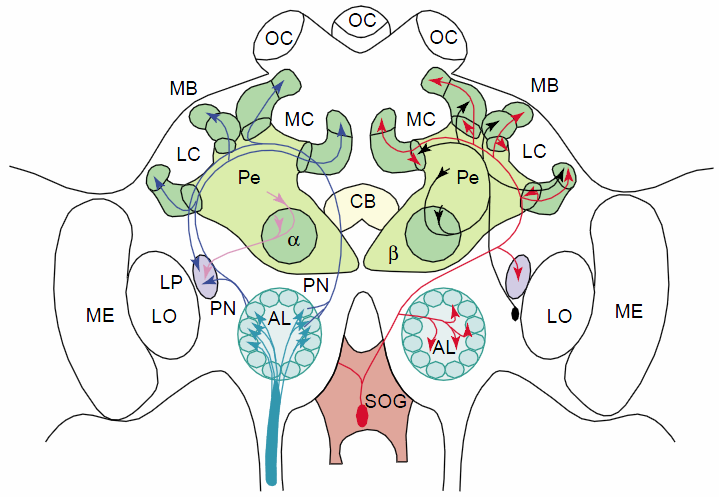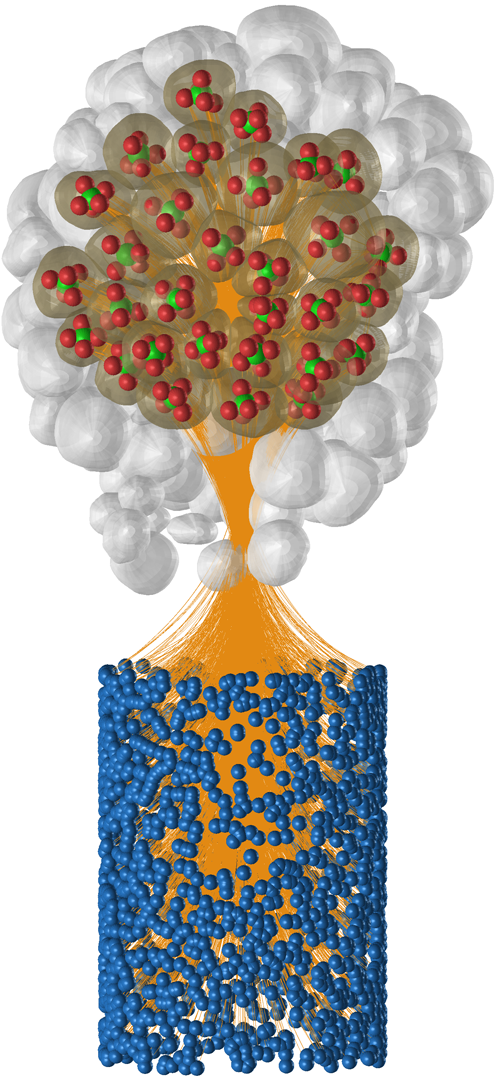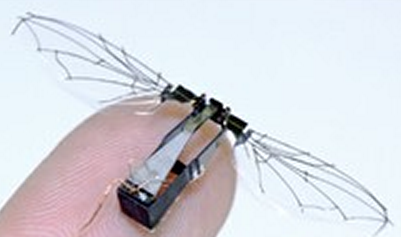‘Green Brain’ project to create autonomous flying robot with honeybee brain
October 2, 2012

The honeybee brain: a schematic view of the major neuropils of the central brain area excluding the eyes, showing the olfactory pathway (credit: Randolf Menzel and Martin Giurfa/TRENDS in Cognitive Sciences)
Scientists at the Universities of Sheffield and Sussex are embarking on an ambitious project to produce the first accurate computer models of a honeybee brain in a bid to advance our understanding of Artificial Intelligence (AI) and how animals think.
The team will build models of the systems in the brain that govern a honeybee’s vision and sense of smell. Using this information, the researchers aim to create the first flying robot able to sense and act as autonomously as a bee, rather than just carry out a pre-programmed set of instructions.
If successful, this project will meet a major challenge: building a robot brain that can perform complex tasks as well as the brain of an animal. Tasks the robot will be expected to perform, for example, will include finding the source of particular odors or gases in the same way that a bee can identify particular flowers.

Model of a bee’s antennal lobe (top) and olfactory receptor neurons on the antennae (bottom) (credit: Thomas Nowotny)
Green vs. blue
It is anticipated that the artificial brain could eventually be used in applications such as search and rescue missions, or even mechanical pollination of crops.
“The development of an artificial brain is one of the greatest challenges in Artificial Intelligence,” said Dr. James Marshall, who is leading the £1 million Engineering and Physical Sciences Research Council (EPSRC) funded project in Sheffield. So far, researchers have typically studied brains such as those of rats, monkeys, and humans, but actually ‘simpler’ organisms such as social insects have surprisingly advanced cognitive abilities.”
Called “Green Brain,” the project invites comparison with the IBM-sponsored Blue Brain initiative, which is developing brain modeling technologies using supercomputers with the ultimate goal of producing an accurate model of a human brain.
Reverse-engineering a bee brain
Green Brain’s researchers anticipate that developing a model of a honeybee brain will offer a more accessible method of driving forward our knowledge of how a brain’s cognitive systems work, leading to advances in understanding animal and human cognition. “Because the honeybee brain is smaller and more accessible than any vertebrate brain, we hope to eventually be able to produce an accurate and complete model that we can test within a flying robot,” said Marshall.
“Not only will this pave the way for many future advances in autonomous flying robots, but we also believe the computer modelling techniques we will be using will be widely useful to other brain modeling and computational neuroscience projects,” said Dr. Thomas Nowotny, the leader of the Sussex team.
The research is also expected to provide a greater understanding of the honey bee itself. Because of their role as pollinators, honey bees are vital to many ecosystems, yet their declining population in recent years has given scientists cause for concern.

Robobee (credit: Harvard School of Engineering and Applied Sciences)
Green Brain’s modelling could help scientists to understand why honey bee numbers are dwindling and also contribute to the development of artificial pollinators, such as those being researched by the National Science Foundation-funded Robobees project, led by Harvard University.
The project sounded (to us at KurzweilAI) very ambitious, but Dr. Marshall clarified the scope in an email: “Initially we’re focusing on olfactory learning, which has been comparatively well studied, and visual learning, which has been less well studied, at least neuroscientifically.
“We have only around 10 person years of effort on this project, but we hope in the future to build larger research networks, across Europe for example, to develop this research agenda further. So, this is the first project it what I hope will be a sequence of projects, assembling the pieces of this massive jigsaw puzzle.”
We were also interested in how they might collaborate with the Harvard Robobees researchers. “The Harvard-led Robobees project has a complementary focus… in fact the Robobees project supported our own proposal, and we have plans to exchange research results between projects at the end of our first 3 years,” he said.
“A lot of the Robobees work is looking at miniaturizing robotics technologies towards the scale of a real honeybee. We’re looking at making biologically plausible models of the bee brain, but without any constraints about making a robot as small as a bee.”
The project is partially funded by NVIDEA. NVIDIA is also providing high-performance GPU accelerators, which generate the 3D graphics on home PCs and games consoles and power some of the world’s highest-performance supercomputers. These accelerators provide an efficient way of performing the massive calculations needed to simulate a brain using a standard desktop PC — rather than on a large, expensive supercomputing cluster.
“Using NVIDIA’s massively parallel GPU accelerators for brain models is an important goal of the project as they allow us to build faster models than ever before,” Nowotny explained.